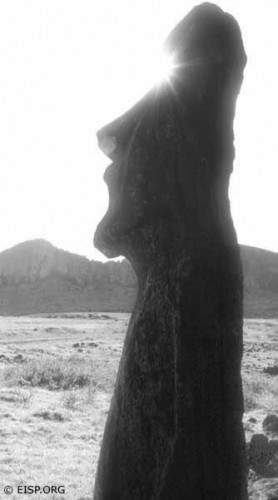What is the Easter Island Statue Project?

Empty eyesockets of a bearded moai standing near Ahu Tongariki are filled with sunbeams. Photo by David C. Ochnser, 1989.
The monolithic statues of Rapa Nui (Easter Island) are called moai in the Rapanui language. Carved on the island by the ancestors of the current population, approximately 50% of the total of 887 statues documented to date still remain in the immediate vicinity of Rano Raraku, the quarry in which they were produced. The majority of the remaining statues were transported to and erected upon a variety of ceremonial structures called ahu. This feat is one of the greatest megalithic achievements of Pacific prehistory.
EISP is the longest collaborative and evolving artifact inventory ever conducted within the context of the Easter Island archaeological survey. Our primary goals are scientific. Our basic purpose is to shed light on the complexities of prehistory, and to integrate the moai into the unfolding time line of Rapa Nui prehistory. We aim to locate, describe, and understand the original context and use of all statues, including those in museums. Context and use, it is hoped, will reveal meaning. Our methods include archaeological survey, artifact description, research into the meaning of symbols, and cultural history interpretation. Our tools have always included camera, compass, measuring tape, and field notebook. Over time we have added large-scale calipers, the latest in GPS mapping technology, and advanced computer data management.
We have two other goals: to provide the results of our work to Rapa Nui families and to the island’s public agencies that are responsible for conservation and preservation of the moai. To that end, we have created an irreplaceable archive of unique documentation. It is anticipated that by making this study more accessible to colleagues we will further the critique of our goals, methods, and findings. Finally, it is hoped that students and the interested and concerned public will gain increased insight into Rapa Nui prehistory.
Why is EISP Important?
Once the Easter Island moai have been thoroughly documented, we are able to pose many questions about their context, use, and meaning. Through understanding the symbolic meaning and function of the statues in the prehistoric society, we may come to understand aspects of ancient social organization as well. The role of the statue cult as a component of technological development and subsequent ecological degradation is central to tracing the arc of statue form change and culture transformation over time.
Within Polynesia, it has been shown that continuity and unity in the design vocabulary are functions of what some researchers have termed a genetic relationship between all Polynesian cultures. This means that comparisons between prehistoric symbolic objects (such as Easter Island statues, for example) and similar objects or motifs known from other Polynesian islands are relevant. Relevant comparisons occur wherever a good case can be made between the archaeological past and the ethnographic present. Models for this type of interpretive study are found in both iconographic analysis and linguistics.
The continuity, unity, and congruence of how the human form was used in art, across Oceanic time and space, suggests the existence of a common, underlying “ancestral” Polynesian theme. The embodiment of that theme appears to be evident in the sculpture and funerary customs of Easter Island.
 English
English  Español
Español